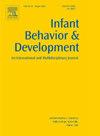Motor developmental trajectories in infants with an elevated likelihood of autism spectrum disorder: A prospective cohort study
IF 1.9
3区 心理学
Q3 PSYCHOLOGY, DEVELOPMENTAL
引用次数: 0
Abstract
Motor skills in infants with autism spectrum disorder (ASD) may reveal early potential indicators of ASD. This prospective cohort study investigated the developmental trajectories of motor skills in infants with an elevated likelihood of ASD from three time points. The Gesell Developmental Schedules were used to collect prospective, longitudinal data from infants aged 6–24 months. The Autism Diagnostic Observation Schedule was employed for the clinical symptoms of ASD at 18–24 months. Latent class trajectory modeling was applied to identify distinct groups of infants with an elevated likelihood of ASD exhibiting similar motor skills trajectories. The final analysis included 121 infants. At the 24-month follow-up, two distinct gross motor trajectory classes, and three distinct fine motor trajectory classes were identified. Compared to a stable trajectory of gross motor developmental, the variable trajectory was associated with an ASD diagnosis, while the trajectory of fine motor skills showed no significant association. These results provide valuable insight into ASD-specific developmental trajectories and promote the identification of developmentally personalized ASD treatments.
自闭症谱系障碍患儿运动发育轨迹:一项前瞻性队列研究
自闭症谱系障碍(ASD)婴儿的运动技能可能揭示ASD的早期潜在指标。这项前瞻性队列研究从三个时间点调查了ASD可能性升高的婴儿运动技能的发展轨迹。使用格塞尔发育时间表收集6-24个月婴儿的前瞻性、纵向数据。采用《自闭症诊断观察表》对患儿18-24个月时的ASD临床症状进行观察。潜在类别轨迹模型被应用于识别具有相似运动技能轨迹的ASD可能性升高的不同婴儿组。最终的分析包括121名婴儿。在24个月的随访中,确定了两个不同的大运动轨迹类别和三个不同的精细运动轨迹类别。与稳定的大动作发展轨迹相比,可变轨迹与ASD诊断相关,而精细运动技能轨迹与ASD诊断无显著关联。这些结果为ASD特异性发展轨迹提供了有价值的见解,并促进了ASD发展个性化治疗的确定。
本文章由计算机程序翻译,如有差异,请以英文原文为准。
求助全文
约1分钟内获得全文
求助全文
来源期刊

Infant Behavior & Development
PSYCHOLOGY, DEVELOPMENTAL-
CiteScore
4.10
自引率
4.80%
发文量
94
期刊介绍:
Infant Behavior & Development publishes empirical (fundamental and clinical), theoretical, methodological and review papers. Brief reports dealing with behavioral development during infancy (up to 3 years) will also be considered. Papers of an inter- and multidisciplinary nature, for example neuroscience, non-linear dynamics and modelling approaches, are particularly encouraged. Areas covered by the journal include cognitive development, emotional development, perception, perception-action coupling, motor development and socialisation.
 求助内容:
求助内容: 应助结果提醒方式:
应助结果提醒方式:


